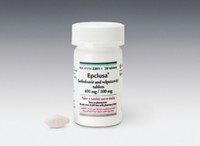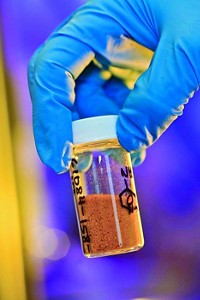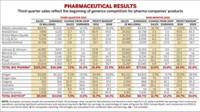Advertisement
Grab your lab coat. Let's get started
Welcome!
Welcome!
Create an account below to get 6 C&EN articles per month, receive newsletters and more - all free.
It seems this is your first time logging in online. Please enter the following information to continue.
As an ACS member you automatically get access to this site. All we need is few more details to create your reading experience.
Not you? Sign in with a different account.
Not you? Sign in with a different account.
ERROR 1
ERROR 1
ERROR 2
ERROR 2
ERROR 2
ERROR 2
ERROR 2
Password and Confirm password must match.
If you have an ACS member number, please enter it here so we can link this account to your membership. (optional)
ERROR 2
ACS values your privacy. By submitting your information, you are gaining access to C&EN and subscribing to our weekly newsletter. We use the information you provide to make your reading experience better, and we will never sell your data to third party members.
Business
Pharma Continues To Flounder
U.S. companies have lackluster results in the second quarter, but flu treatments could help european firms
by Lisa M. Jarvis
August 17, 2009
| A version of this story appeared in
Volume 87, Issue 33

It’s clear from second-quarter results that major drugmakers continue to have a tough time growing. U.S. firms looked particularly stagnant, with few companies managing to eke out improved sales and earnings. Their European counterparts fared better, helped by diversified portfolios that include vaccines. In general, European companies are poised to benefit as government agencies place huge orders for vaccines and antivirals in preparation for a swine flu pandemic.
Overall, many big pharma companies are struggling to reinvigorate product sales, although profits continue to improve because of deep cost-cutting measures. Overall second-quarter sales for the 13 drug companies tracked by C&EN were down 0.2% from the year-earlier period, and earnings increased by 5.4%. The group’s average profit margin for the quarter was 24.1%, compared with 22.8% in the second quarter of 2008. For the first half of the year, sales improved 0.2%, and earnings increased 3.9%.
For U.S. companies, second-quarter results looked an awful lot like those offered in 2008, with modest earnings increases but little to no improvement in sales. “Sluggish revenues were enhanced on the bottom line by cost cutting,” Deutsche Bank analyst Barbara Ryan said in a recent report on the sector’s performance. Indeed, not one U.S. firm managed to offer much of a sales boost; Johnson & Johnson, Merck & Co., Pfizer, Schering-Plough, and Wyeth all posted sales declines.
Pfizer and Merck are still trying to complete their mergers with Wyeth and Schering-Plough, respectively, with the hope that the combined companies will be stronger than the individual ones. For the quarter, Pfizer’s earnings were down 12.1% to $3.2 billion, based on a 9.4% drop in sales to just under $11.0 billion. Merck’s sales were off 2.5% to $5.9 billion, and earnings fell 5.4% to less than $1.8 billion.
While these U.S.-based companies continue to focus on pushing through their megamergers, Roche is already reaping the rewards of its lengthy struggle to buy Genentech.
The Swiss company experienced healthy growth in the first half of the year, thanks in large part to Genentech’s oncology portfolio. Sales for the half were up 9.1% to $22.1 billion, and earnings increased 10.6% to $4.8 billion.
Of Roche’s 10 top-selling products in the first half of the year, six are legacies from Genentech. Avastin, for colon cancer, brought in $2.9 billion, a 29% jump from the first half of 2008, and the breast cancer treatment Herceptin enjoyed a 10% increase in sales to $2.5 billion. Sales of Rituxan, for non-Hodgkin’s lymphoma, were up 8% to $2.9 billion.
Roche is also one of several big drug companies benefiting from the swine flu outbreak. Half-year sales of the antiviral Tamiflu totaled $952 million—more than double the sales in the first six months of 2008.
In fact, Roche says Tamiflu accounted for almost half of the overall growth in its pharmaceuticals business in the first six months of the year. The company is expanding capacity both internally and through contract manufacturers and will be able to supply 400 million packs of Tamiflu annually by the beginning of 2010.
GlaxoSmithKline makes Relenza, the other approved antiviral used to treat those infected with swine flu, and the firm is also developing a vaccine against the virus. Between governments and the World Health Organization, GSK has been contracted to supply 195 million doses of the vaccine. Its pact with the U.S. is worth $250 million, and the company is in talks with more than 50 other governments. GSK expects to begin delivering vaccine to governments in September, after which it will allot 20% of the output at its Canadian plant to developing countries.
Second-quarter sales of Relenza were $101 million, compared with $5 million in the same period last year. The company is investing to increase output of the antiviral; by the end of the year, it will have tripled annual Relenza capacity to 190 million treatment courses.
GSK’s broader vaccine business grew by 14%, helping bolster overall results for the quarter. In fact, the company posted the most robust sales growth of all the big pharma firms—a 14.9% increase to $11.1 billion. Second-quarter earnings were up 10.5% to $2.6 billion.
Novartis is also poised to benefit from the swine flu outbreak. Like GlaxoSmithKline, the Swiss firm has received large orders for the H1N1 vaccine and its adjuvant, a component that boosts delivery of the vaccine. The U.S. government alone has awarded the company vaccine and adjuvant contracts worth $979 million. Novartis is using traditional egg-based production as well as cell-culture manufacturing—a newer, faster technique—to produce the H1N1 vaccine. Clinical trials for its cell-culture-based vaccine began last month.
Despite the pending windfall from swine flu sales, the recent performance of Novartis’ vaccines unit underscores how lumpy the pandemics business can be. Its second-quarter sales of vaccines and diagnostics dropped 23% to $247 million because of the lack of demand for the H5N1, or bird flu, virus vaccine.
Overall, Novartis’ second-quarter earnings were down 9.8% to $2.0 billion, based on a 1.7% decline in sales to $10.5 billion. Pharmaceuticals were the firm’s healthiest business, thanks to growth in its oncology portfolio. Sales of Gleevec, for chronic myeloid leukemia, were up 24% to $268 million, and the breast cancer treatment Femara brought in $141 million, an 18% increase. The cardiovascular franchise also looked solid, particularly the hypertension drug Tekturna, which saw quarterly sales double to $119 million.
Bird flu—or the lack thereof—also caused a drop in Sanofi-Aventis’ second-quarter vaccine sales, although the company had no trouble offsetting the loss with sales from prescription and over-the-counter products. Second-quarter earnings improved 29.4% to nearly $3.2 billion, based on an 11.2% rise in sales to $10.4 billion.
H5N1 vaccine sales for the quarter totaled $32.5 million, compared with $192 million in the second quarter of 2008. However, sales for the rest of the company’s vaccines portfolio grew by 18.4%. At the end of the quarter, Sanofi agreed to buy Indian vaccines maker Shantha Biotechnics to expand its presence in emerging markets (C&EN, Aug. 3, page 16).
Sanofi is another company tasked with manufacturing the swine flu vaccine. It has received at least $190 million in bulk vaccine contracts from the U.S. and an order for 28 million doses of vaccine from the French government.
The company said clinical trials for its vaccine, which will involve 2,000 people, began in the U.S. on Aug. 6. It plans to test the merits of adding an adjuvant to the vaccine.
Gilead Sciences also has a stake in the swine flu scare. The company is the discoverer of Tamiflu, which brought it $52 million in second-quarter royalties, an increase of 38%. Gilead also benefited from strong growth in its antivirals franchise. Sales of the HIV treatment Atripla surged 60% to $569 million, and Truvada brought in $608 million, up 18%.
Yet Gilead is not immune to competitive pressures. It is trying to diversify its business beyond the antivirals, which will eventually lose patent protection. In the quarter, Gilead completed its $1.4 billion purchase of CV Therapeutics, a biotech firm focused on making cardiovascular drugs. In addition to the angina drug Ranexa, the deal brought in an experienced sales team that will better position Gilead’s darusentan, an antihypertensive in Phase III development, when it hits the market.
Overall, Gilead outperformed its biotech industry contemporaries, which have struggled to expand in the absence of new products. Biogen Idec’s second-quarter sales, helped by growth of the multiple sclerosis drug Tysabri, were up 10.1% to almost $1.1 billion, but earnings of $219 million were down 18.6% from the prior year.
Meanwhile, Amgen posted a 6.2% rise in second-quarter earnings to $1.3 billion, even though sales declined 1.4% to $3.7 billion. The firm’s sales and earnings both dipped in the first half of the year.
But Amgen, the biggest of the biotech firms, appears poised to make a comeback. A Food & Drug Administration advisory panel met last week to decide whether to recommend approval of Amgen’s highly anticipated osteoporosis treatment denosumab. Analysts expect the agency to give the drug the green light in October and believe it will bring in more than $1 billion in sales by 2012.
Amgen is attempting to maximize sales of denosumab while minimizing its own costs. The company recently partnered with GlaxoSmithKline to market the drug in Europe, Australia, New Zealand, and Mexico—but only for osteoporosis. Amgen is developing the drug on its own for oncology indications.






Join the conversation
Contact the reporter
Submit a Letter to the Editor for publication
Engage with us on Twitter